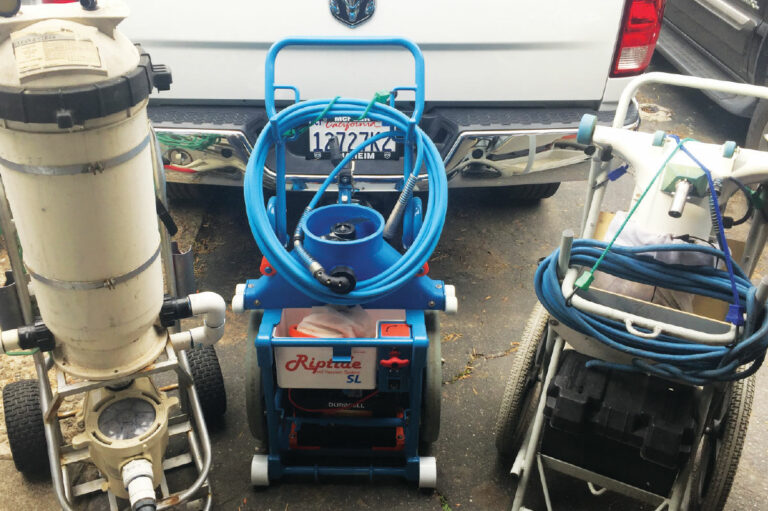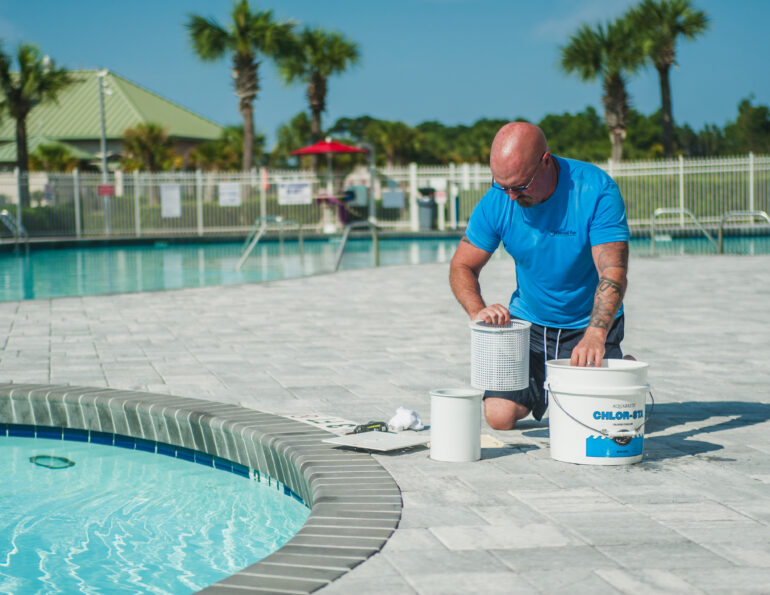Closing Time

Few industries are more cyclical and seasonal than the pool business.
Homeowners naturally want to extend the season and close their pools as late in the year as possible. This forces pool companies and their service departments to cram the critical closing season into a short, frantic, whirlwind few months. In regions where savage and sometimes early winters can brutalize pools that aren’t prepared for the deep freeze, the stakes are raised — and technicians are under even greater pressure to perform.
Business owners rely on a blend of creative scheduling, staff juggling and raw experience to persevere through the annual ritual of scrambling to close every pool by winter. Most can claim success only if they emerge in the spring to answer just as many phone calls from the same customers who now want to reopen their pools for the summer.
Closing Season
Limited Time, Infinite Challenges
Michael Giannamore is the vice president of Aqua Pool & Patio Inc., and the president of the company’s service division, which services pools across Connecticut, Rhode Island and Massachusetts.
Giannamore wastes no time identifying the biggest perennial challenge of closing season: Unreasonable customer expectations. “The typical consumer doesn’t understand that the rain we had last Friday pushes everybody off,” he says. “Even though the rain stopped at 2 p.m., all the guys who did go out in the morning to work in the rain were soaking wet and freezing cold and went home — and I can’t force them to work in the rain.”
The solution to soothing impatient customers, Giannamore says, is communication. It starts with the inclusion of clear “weather permitting” disclaimers on every document. The dialogue continues throughout the season, however, on a one-on-one basis.
“It’s about taking the call, hearing them out and telling them where we stand,” Giannamore says.
In many cases, however, the real obstacles can only be solved with technical know-how.
Mike Giovanone is the president and CEO of Concord Pools and Spas, which has three locations north of Albany in Upstate New York.
Giovanone, whose team winterizes roughly 5,500 pools every season, knows the right way to close a pool depends on which pool you’re closing and when.
“There’s a science behind it,” Giovanone says. “If you’re closing a pool in November, you’re going to close that pool differently than one you close at the end of August or the beginning of September. You know the November pool is going to be frozen in a month.”
Giovanone describes the importance of venting pools that are closed early in the season. If a tech skips that step, harmful gasses can build up between the water and airtight cover.
“That gaseous buildup can just destroy any pool,” he says. “Your guys have to know how to manage it.”
Scheduling
Dozens of Days, Thousands of Pools
During the busy fall season, Giovanone’s teams close more than 100 pools a day. The only way to manage the workload is with a rigid schedule based on a geographic grid of his territory.
“When we have a crew go out and close a dozen pools in one day, they’ll never leave the neighborhood,” Giovanone says. “I’ll have one truck in one quadrant of about a square mile all day.”
The trick is only giving customers options that work within his predetermined itinerary.
“When a client calls in, we offer them the two days a week when we’ll be in their area,” he says. “And that’s it.”
True Pros vs. ‘Two Guys in a Truck’
You Are Who You Hire
Every pool closing is only as good as the people who perform it.
“You just can’t send out two guys in a truck to close a pool,” Giovanone says.
Training, technique and knowledge of machinery and systems can make or break a season, which can, in turn, make or break a business. Giovanone says many failures can be attributed to ignorance, short cuts or a combination of the two.
“I’ll see pool guys towing out diesel compressors,” Giovanone says with a chuckle. “They’ll put 200 pounds of pressure in a line, when it actually has nothing to do with pressure. It has to do with volume. I’ve seen guys take a paint compressor from Sears or borrow one from Uncle Joe, and blast 120 pounds of pressure with such low volume that it’s not vacating the water.”
Giannamore agrees success depends on the professionalism and experience of the technicians in the field.
“Every day I watch the trucks drive off, and I have to trust the guys not to kill the grass or run over the dog or get a speeding ticket,” Giannamore says.
Both men also agreed the only way to find and retain quality talent is to pay employees well, train them well and treat them with respect. From there, however, Giannamore and Giovanone veer off into very different staffing philosophies.
Giannamore cuts his staff when closing season ends, then rehires those who are willing and available to come back when the warm weather returns. His 18 service technicians get laid off some time in the fall and return some time in the spring.
His strategy is to pay them enough so they can live without another job over the winter, survive on unemployment benefits and return for the busy pre-summer rush of pool openings. In reality, however, the lapse in work inevitably leads to turnover and new faces.
“That’s the struggle,” Giannamore says. “Employee retention is the most important thing and the hardest thing.”
Giannamore incentivizes his employees to return by contributing 3 percent to their 401(k)s, even if the employee contributes nothing. He also pays his crews from punch-in to punch-out without ever cutting hours. Although Giannamore once helped a few workers find jobs delivering heating oil in the winter, he admits that was a fluke.
“We don’t want them to get jobs in the winter,” Giannamore says. “What if they like their new job better? What if they like their new paycheck better?”
Giovanone is not willing to take that risk. “I could never chance retraining someone,” he says. “If you’re going to lay off your key people who are integral to your business, then you’re going to lose them. And I can’t afford to lose them.”
Instead, Giovanone relies on a nucleus of seven, two-person service crews, all of whom are 100 percent full-time — and long-time — employees.
“My new guy has been here for 18 years,” he says jokingly, although the statement is true. “I hired most of these guys as kids, and now their kids work for us.”
In one case, he hired a freshman in high school who stayed on through graduation, all through college and then through law school. “Now he’s my corporate lawyer,” Giovanone says.
The longevity has fostered a sense familiarity, predictability and responsibility, all of which are critical to surviving the fall closing season.
“When I come in in the morning and we see each other in the hall, we just kind of smile and nod at each other, and then they’re out of there,” Giovanone says. “It’s like clockwork.”
It also breeds efficiency.
“I’ll often have someone ask why they were charged $295 to have their pool closed by a couple of guys who were only there a half hour,” Giovanone says. “My comment, respectfully, is always ‘I could have two untrained guys there for four hours trying to figure it out.’ ”
The tradeoff, however, is that it is no simple task to maintain a full-time staff, including through the lean months, year after year.
“I keep them on no matter how bad it hurts,” Giovanone says.
Unlike so many others in the industry, neither man relies on traditional seasonal help for closing season or any other time.
“We have found that truly seasonal help, like college kids, just doesn’t work,” says Giannamore, who considers his employees to be full time since they all work more than 1,000 hours in a year.
College students are still in school when the frantic spring season begins. It doesn’t make sense, therefore, to hire them halfway through the spring rush and keep them on all summer, just to lose them again halfway through the fall closing rush when they head back to school.
Giovanone and Giannamore rely on different personnel strategies, but they both face the same challenges. The moment Labor Day arrives — and in some cases, even before — they are racing against the same unrelenting clock, facing the same approaching winter and the same dreadful consequences if they don’t complete their closings on time.
Like thousands of pool company owners across the country, the arrival of fall for both men means months of delicate customer discussions, non-negotiable scheduling and workforce realities.
“To close that many every year,” Giovanone says, “it’s sort of an art and a science.”






